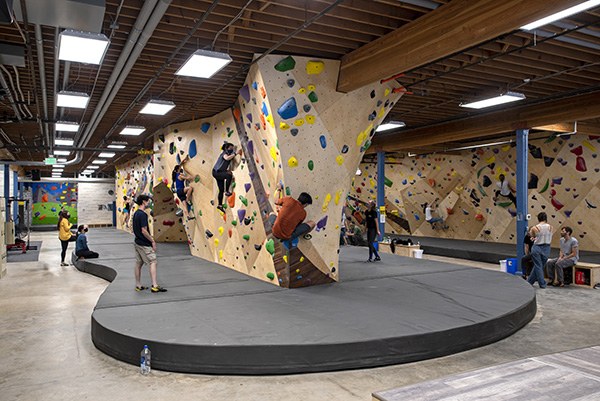
Streaks of glue are glistening in our hair and work overalls from another late night working on the bouldering gym’s construction. My life partner Daniel is putting up wall paneling while I assist, a wet rag in my hands to wipe away residue from the installation. We’re exhausted and elated at the same time. It seems surreal to be putting the finishing touches on a project that has absorbed the last five years of our lives. In building Half Moon Bouldering, our family start-up and the first bouldering gym in Greenwood, we feel like we’ve been aiming for the moon, and now it seems we’re actually close to landing.
I have to smile as Daniel mutters about the irregular corners of our mid-20th century building. Small details like this are charming, until you have to deal with construction and straight lines. Like many small businesses before us, we’re doing pretty much everything ourselves – from strategic planning to construction work – and I reflect on the many skills we have yet to hone. Our gym is in the space that belonged to Top Ten Toys, one of Seattle’s iconic family-owned businesses whose owners recently retired. I am keenly aware that we are stepping into big shoes, and we hope to become as much a part of the community as our predecessors had been.
Filling a need
In December 2020, after five years of planning, we reached the final stretch of building Half Moon Bouldering (our official opening was delayed until March of 2021 due to the pandemic). We wanted to create an inclusive, intergenerational gym, welcoming people of all skill levels and ages. Hiring our first staff felt like a miracle at the end of an unprecedented year. The two of us were betting all we had by opening an indoor bouldering crag in the middle of uncertain times.
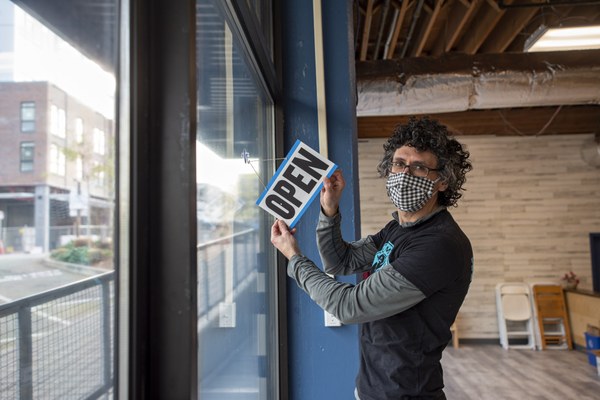 Daniel officially opening Half Moon Bouldering.
Daniel officially opening Half Moon Bouldering.
In pre-pandemic days, our plan looked solid; the market practically begged for a new climbing gym. Though Seattle has a wide-spread climbing culture, in 2019 there weren’t any commercial climbing gyms in the city’s northern neighborhoods. The sport’s popularity continues to rise today as climbing and bouldering become mainstream activities, with many people first learning about climbing as an indoor sport. Half Moon Bouldering was created to fill a gap in access based on the sport’s demand.
Roots
While it made sense from an economic perspective to build in the heart of Greenwood, we were also driven by a fundamental desire to spread roots in this green city that we came to love as our adoptive home. Daniel and I grew up behind the Iron Curtain during the worst years of the communist dictatorship in Romania. We learned early in life the importance of escaping the drab city with its gray buildings, unkempt muddy roads, empty grocery stores, electricity shortages, and communist propaganda. We turned to the outdoors. Happy snapshots from our youth show us traveling on long, snail-paced trains to the foothills of the Carpathian Mountains; hitchhiking on horse-drawn carts stacked high with hay; backpacking for days on end, with heavy hand-me-down packs and not-quite waterproof tents.
We spent our days soaking in the beauty of ancient Transylvanian forests and the wild Carpathians, and we loved every minute of it.
 Rural Romania.
Rural Romania.
Our dirtbag habits served us well throughout early adulthood, during the 1990s and early 2000s when the Romanian economy was desperately struggling. Yet, these happy memories carry with them the somber backdrop of the time and place in which they originated. For us, as for many others coming from an environment of economic disadvantage due to political or social circumstances, escaping to nature’s wonderland was inherently tinged with the melancholic realization that we could not afford traveling far and wide. One of my most poignant childhood memories, which would have a profound impact on Half Moon Bouldering’s vision, is from my World Geography class in middle school. I saw pictures of Yellowstone, Yosemite, and Redwoods National Park. My exuberant 11-year-old imagination quickly transported me there, among the sky-high trees and limitless plains. It dawned on me that as a subject of a totalitarian regime, traveling to the West would be almost impossible. At the time, I did not know I would be among the lucky few who were able to emigrate and establish a comfortable middle-class existence in their adoptive countries.
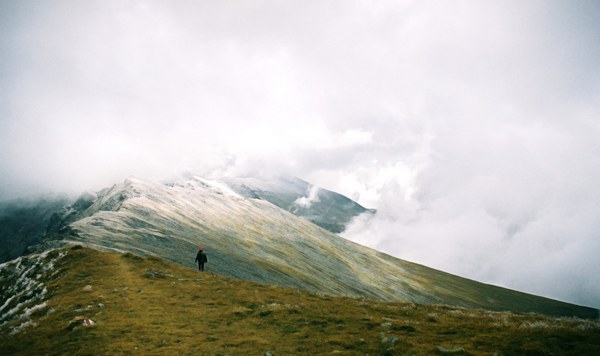 Gloria in the Parang Mountains in Transyvlania, Romania, August 2003. Photo by Daniel Man.
Gloria in the Parang Mountains in Transyvlania, Romania, August 2003. Photo by Daniel Man.
Discovering climbing
Daniel and I discovered climbing only after coming to the United States. First at Planet Rock in Ann Arbor, Michigan, and then, after moving to Seattle in the late 2000s, at Husky Rock and Stone Gardens. Enveloped in college culture and displaying an aura of carefree bravado, some of the climbers we encountered in these places were both fascinating and intimidating. People coming to the climbing gym seemed fairly well off, if not in their immediate financial situation (as is typical among the college crowd), at least in their consciousness of being rooted in the middle class. To two immigrants from an economically-disadvantaged country, it was quite apparent that most of the gym-goers belonged to a social class with access to education and maybe a touch of entitlement. There also seemed to be an unspoken barrier, a certain lack of approachability to those who looked the part of the “regular.” We felt a nagging suspicion that most climbers were trapped under some unhealthy pressure that they were putting on themselves. Many missed the opportunity to engage with others, Daniel and I included.
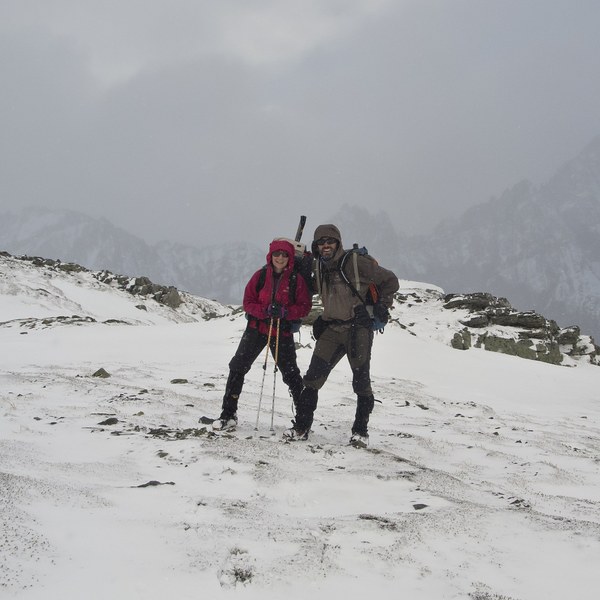 Gloria and Daniel on the Sahale Arm, North Cascades.
Gloria and Daniel on the Sahale Arm, North Cascades.
This environment presented a vague invitation to carve out a space where climbers would thrive in each other’s company if they’d just let their guard down a bit. This nagging thought would feed into Half Moon Bouldering’s emergence as a place that would aim to lower the threshold of access to the gym and welcome visitors the way they were.
After a few trips to outdoor crags like Exit 38, Frenchman Coulee (back in the days before it had a toilet), or Squamish, we got to take in a wider view of local climbing culture. It was refreshing to see families and different generations climb together. A more open, more relaxed atmosphere dotted with moments of joyful interaction. We would join in conversations around the campfire, sharing the day’s impressions with other climbers. Or witness the community pitching in for maintenance or stewardship. We also had the opportunity to see organizations like The Mountaineers play a crucial role in protecting the outdoor places in which we thrive as individuals and as a community (and put in a toilet at Frenchman Coulee!). Experiences like these have crystalized for us how important it is for indoor climbing gyms to partner with nonprofits and be actively engaged in outdoor stewardship and education.
Taking the leap
During the gym’s build-out, the two of us faced sharp career and life changes. I had given up my 10-year long teaching position and was bracing for the difficult transition of putting my private German-language school on hold to focus exclusively on the gym. Daniel was keeping his full-time job as a software developer to feed our family and the ravenous financial appetite of a fledgling business. Meanwhile Clara, our 7-year-old, was seeing her parents fully absorbed in the build-out project. The gym was starting to seriously infringe on our quality time. On the other hand, we were always together, with Clara and our 11-year-old German shepherd Ol’ Man Zack in charge of keeping spirits high. This included playing catch in the empty hall, bouncing around joyfully, and making sure treats and breaks were plentiful.
By opening Half Moon Bouldering, we were fulfilling a life-long dream, building a bridge between our daily urban existence and our love for the outdoors. We envisioned a climbing gym that went beyond a space to stay fit in winter - a business engaged in outdoor stewardship and education, a gathering spot to host the next generation of climbers. Even before it opened, we set aside a portion of Half Moon Bouldering’s sales for free gym passes. In its first nine months, the gym raised funds for and created partnerships with local nonprofit organizations such as Climbers of Color (via The Mountaineers), the Washington Climbers Coalition, Treehouse for Kids, She Rocks, and more. By our second year we hope to offer scholarships for under-resourced youths. Increasing gym access to those who need it is important to us, not only because it feels like the right thing to do, but because we know how meaningful an escape to the outdoors can be.
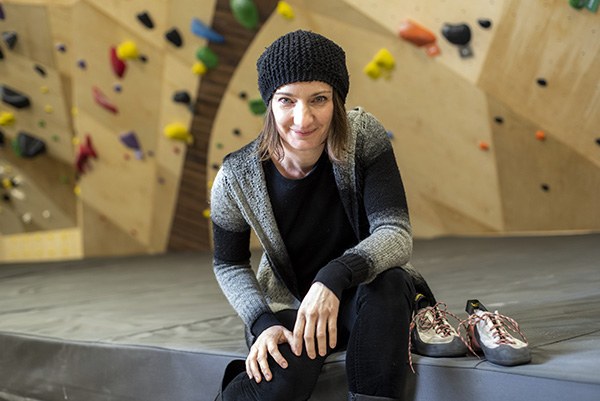 Gloria Man at Half moon Bouldering.
Gloria Man at Half moon Bouldering.
A space for everyone
Today, indoor climbing is moving into the mainstream. It’s a moment of opening up. During the pandemic, the Seattle area grew by three bouldering gyms, including Half Moon Bouldering. Indoor bouldering, with its short walls and lack of equipment, acts as a gateway to the sport. At the same time, its demand for technical skills and an analytical approach proves attractive to seasoned climbers of all backgrounds. Moreover, with its inherent sociability, bouldering bridges the gap between skills, age, and identity.
As many would agree, one of the best experiences at Half Moon Bouldering - or perhaps any indoor bouldering space - emerges when onlookers create spontaneous groups to encourage a climber on the wall. Under the collective task of solving a problem, there’s always the potential of a burgeoning friendship. You never know who your next bouldering session will bring into your orbit. What if it’s (tongue in cheek) an immigrant couple from Romania, or (in earnest) a kid from a neighborhood you’ve never visited, or (outlandishly) someone who sat around the campfire with Lynn Hill?
With the growing number of indoor climbing venues in the Seattle area, there is a huge opportunity for climbing to become more inclusive and equitable. Groups like Climbers of Color are partnering with commercial climbing gyms to host climb nights and to offer scholarships to historically marginalized communities, an instrumental part of this change. As newcomers on the climbing map, we are honored to take part in this moment in time. It’s inspiring to know that we’re part of a larger movement.
The next time you come into our climbing gym, we hope you’ll be glad to know that you are contributing to these efforts by allowing us to set aside a portion of our income for inclusivity efforts and outdoor stewardship. We encourage you to join a women’s, BIPOC, or family climbing event. Above all, we hope you’ll be inspired to engage with the people around you and remain open to the potential of a unique experience as we climb together.
This article originally appeared in our Spring 2022 issue of Mountaineer Magazine. To view the original article in magazine form and read more stories from our publication, visit our magazine archive.
CLIMBERS ENJOYING THE NEW SPACE. All photos courtesy of Gloria and Daniel Man.
Add a comment
Log in to add comments.Amazing! What a great story for starting my day. Thank you Gloria.😀
 Gloria Man
Gloria Man